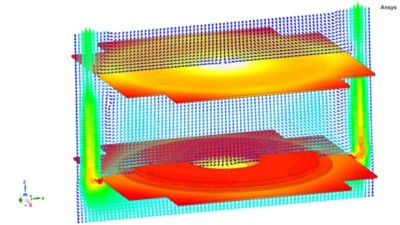Wireless Charging Simulation
Wireless Power Transfer
Ansys offers a full end-to-end wireless power supply system analysis with physics-based system modeling.
Design for Wireless Charging
As requirements for wattage and power densities increase, designing for higher efficiency and optimized thermal performance becomes critical for meeting tomorrow’s consumer needs.
Developing a design for an efficient and reliable wireless charging device depends on ability to model the electromagnetic and thermal performance of the transmit and receiver coils, as well as inclusion of the controls and power electronics.
Ansys solutions incorporate magnetic, thermal, and electrical system performance and enable the design optimum wireless chargers for electric vehicles, consumer electronic and medical devices.
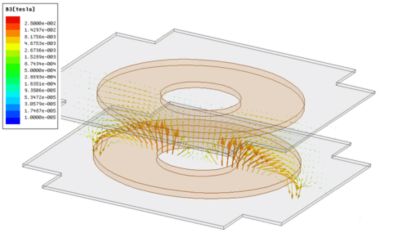

Reduced time to market
Automatic adaptive meshing ensures designers have an accurate, efficient, and appropriate finite element mesh for the physics being solved, regardless of the geometry and resulting field concentrations; this ensures the engineers can design the product and not design the mesh. An integrated tool suite in the Ansys Electronics Desktop ensures model sharing and consistency of design iterations.
Increase Efficiency & Range
Optimal magnetic design ensures maximum efficiency for a given design at recommended or non-ideal distances.
Changes in ferrous concentrators, shielding, or coil design will impact the performance of the device.
Factors such as unintentional external ferrous or conductive objects may reduce efficiency, and these can be studied with simulation.
Transmit and receiver coil misalignment will cause a reduction in efficiency.
Reducing Cost
Ansys Simulation can be used to consider design cost reductions through shape and topology studies as well as tradeoffs in performance vs dollar cost for different materials. Changing materials of an existing design may impact the performance, cost, lifetime and potentially increase warranty costs. Assessment of these changes using simulation reduces risk.
Superior Product Design
Wireless Charging devices require electromagnetic, thermal, electronics, structural integrity. Ansys provides a full suite of simulation tools to help get designs to market faster.
Featured Products
Better and Faster Design of Wireless Charging Systems
Wireless charging systems face electromagnetic, thermal and Power Electronics design challenges. To reach the stringent design goals, customers require robust Multiphysics simulation approaches.

Electromagnetic Performance Through Inductive Coupling
Maxwell’s finite element method technique uses automatic adaptive meshing technology to predict coil coupling inductance for any sized coil under any misalignment condition. It includes effects of permanent magnets, magnetic materials, and losses due to eddy effects in conductive shields or nearby objects unprotected from stray fields that may emanate outside the device footprint.
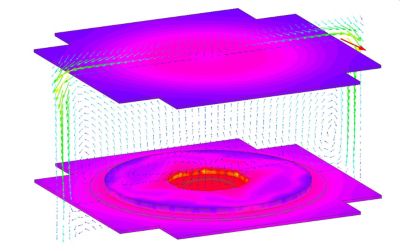
Temperature Prediction of Transmit and Receive Coil Structures
Transmitting power, even wirelessly, will generate heat in transmitting and receiving coils, as well as in the magnetic and conductive parts of the wireless charging devices. Heat may also be generated unintentionally in nearby parts. Predicting where heat originates and designing for thermal performance under different charging loads is imperative for optimum designs to meet or beat temperature limits.
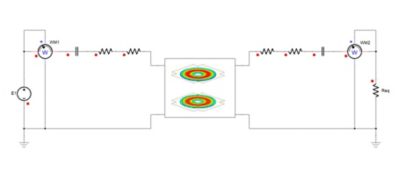
Electrical System Performance
Wireless charging system efficiency depends on many factors, including coil quality factors, losses, and control strategies. Enabling magnetic FEA reduced order models for circuit and system simulation allows for accurate prediction of system efficiency as well as power electronics topologies for sensing and controls. This workflow enables engineers to achieve new power levels, higher efficiency, and reduce product cost of new or existing designs.
Featured Webinars
Webinars
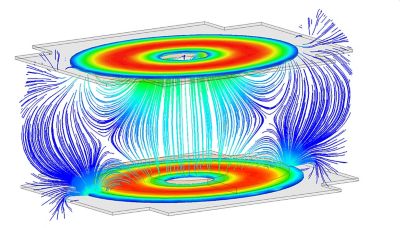
Wireless Charging Systems – Create Better Designs Through Simulation
Learn how to model and analyze inductive-based wireless charging systems using Ansys Maxwell for optimum design.

Modeling Inductive-Based Wireless Power Transfer Using Ansys Maxwell
Inductive-based wireless power systems are used to charge biomedical implants, consumer electronics, and even electric vehicles; this approach can be advantageous since it does not require electrical contacts to transfer power. Design goals usually include maximizing efficiency to reduce charge times, which requires accurate modeling of the magnetic performance of the coils (including flux concentrators and magnetic shielding), power electronics, controls and thermal performance.
Blogs
시작하기
엔지니어링 과제에 직면하고 있다면우리 팀이 도와드리겠습니다. 풍부한 경험과 혁신에 대한 헌신을 가지고 있는 우리에게 연락해 주십시오. 협력을 통해 엔지니어링 문제를 성장과 성공의 기회로 바꾸십시오. 지금 문의하기














